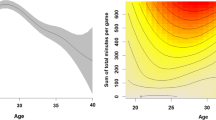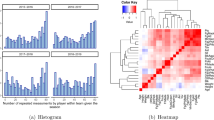Abstract
The impact of age on performance is a fundamental component to models of player valuation and prediction across sport. Age effects are typically measured using age curves, which reflect the expected average performance at each age among all players that are eligible to participate. Most age curve methods, however, ignore the reality that age likewise influences which players receive opportunities to perform. In this paper we begin by highlighting how selection bias is linked to the ages in which we observe players perform. Next, using underlying distributions of how players move in and out of sport organizations, we assess the performance of various methods for age curve estimation under the selection bias of player entry and issues of small samples at younger and older ages. We propose several methods for player age curve estimation, introduce a missing data framework, and compare these new methods to more familiar approaches including both parametric and semi-parametric modeling. We then use simulations to compare several approaches for estimating aging curves. Imputation-based methods, as well as models that account for individual player skill, tend to generate lower root mean squared error (RMSE) and age curve shapes that better match the truth. We implement our approach using data from the National Hockey League. All of the data and code for this paper are available in a Github repository.









Similar content being viewed by others
Notes
MLB stands for Major League Baseball and NBA stands for National Basketball League
Imputation with truncation limits the range of values that generated realizations can take. For example, if \(X \sim N(0,1)\) is truncated below at \(-2\) then the realized values of X could only take values in \((-2,\infty )\) whereas untruncated realizations could take values in \((-\infty , \infty )\).
References
Albert, J. (2002). Smoothing career trajectories of baseball hitters. Unpublished manuscript, Bowling Green State University, at bayes. bgsu. edu/papers/career_trajectory. pdf
Berry, S. M., Reese, C. S., & Larkey, P. D. (1999). Bridging different eras in sports. Journal of the American Statistical Association, 94(447), 661–676.
Bradbury, J. C. (2009). Peak athletic performance and ageing: evidence from baseball. Journal of Sports Sciences, 27(6), 599–610.
Brander, J. A., Egan, E. J., & Yeung, L. (2014). Estimating the effects of age on nhl player performance. Journal of Quantitative Analysis in Sports, 10(2), 241–259.
Fair, R.C. (2008). Estimated age effects in baseball. Journal of Quantitative Analysis in Sports 4(1).
Judge, J. (2020a). An approach to survivor bias in baseball. Baseball Prospectus (https://www.baseballprospectus.com/news/article/59491/an-approach-to-survivor-bias-in-baseball/).
Judge, J. (2020b). The delta method, revisited: Rethinking aging curves. Baseball Prospectus (https://www.baseballprospectus.com/news/article/59972/the-delta-method-revisited/).
Kovalchik, S. A., & Stefani, R. (2013). Longitudinal analyses of olympic athletics and swimming events find no gender gap in performance improvement. Journal of Quantitative Analysis in Sports, 9(1), 15–24.
Lailvaux, S. P., Wilson, R., & Kasumovic, M. M. (2014). Trait compensation and sex-specific aging of performance in male and female professional basketball players. Evolution, 68(5), 1523–1532.
Lichtman, M. (2009). How do baseball players age. Fan Graphs (https://tht.fangraphs.com/how-do-baseball-players-age-part-2/).
Paparrizos, J., Gravano, L. (2015). k-shape: Efficient and accurate clustering of time series. In: Proceedings of the 2015 ACM SIGMOD International Conference on Management of Data, pp. 1855–1870.
R Development Core Team (2007). R: A Language and Environment for Statistical Computing. R Foundation for Statistical Computing, Vienna, Austria. http://www.R-project.org. ISBN 3-900051-07-0
Schulz, R., Musa, D., Staszewski, J., & Siegler, R. S. (1994). The relationship between age and major league baseball performance: Implications for development. Psychology and aging, 9(2), 274.
Tulsky, E. (2014). How shot attempt differential changes with age. https://www.sbnation.com/nhl/2014/3/20/5528472/nhl-stats-corsi-vs-age.
Turtoro, C. (2019). Flexible aging in the nhl using gam. https://rpubs.com/cjtdevil/nhl_aging.
Vaci, N., Cocić, D., Gula, B., & Bilalić, M. (2019). Large data and bayesian modeling-aging curves of nba players. Behavior research methods, 51(4), 1544–1564.
Villaroel, C., Mora, R., & Gonzalez-Parra, G. C. (2011). Elite triathlete performance related to age. Journal of Human Sport and Exercise, 6(2), 363–373.
Wakim, A., Jin, J. (2014). Functional data analysis of aging curves in sports. arXiv preprint arXiv:1403.7548.
Acknowledgements
We would like to thank CJ Turturo for making his code available.
Author information
Authors and Affiliations
Corresponding author
Ethics declarations
Conflict of interest
The authors declare that they have no conflict of interest.
Additional information
Publisher's Note
Springer Nature remains neutral with regard to jurisdictional claims in published maps and institutional affiliations.
This material is based upon work supported by the U.S. National Science Foundation under Grant No. CNS-1919554.
Rights and permissions
Springer Nature or its licensor (e.g. a society or other partner) holds exclusive rights to this article under a publishing agreement with the author(s) or other rightsholder(s); author self-archiving of the accepted manuscript version of this article is solely governed by the terms of such publishing agreement and applicable law.
About this article
Cite this article
Schuckers, M., Lopez, M. & Macdonald, B. Estimation of player aging curves using regression and imputation. Ann Oper Res 325, 681–699 (2023). https://doi.org/10.1007/s10479-022-05127-y
Accepted:
Published:
Issue Date:
DOI: https://doi.org/10.1007/s10479-022-05127-y





